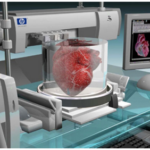

Canadian medical doctors Adnan Sheikh and Bruce B. Forster examine the growing importance of 3D printed models and instruments like surgical tools, outlined in the recently published ‘Holding It in Your Hand’’: Musculoskeletal Applications of 3D Printing.’
Noting the impacts digital fabrication offers to the medical realm, the authors see 3D printing as one of the ‘fastest growing technologies,’ currently revolutionizing many medical practices—and operating rooms.
3D printed medical models are in a category all their own, offering benefits on so many different levels. Doctors and surgeons are able to better diagnose health issues, from tumors to aneurysms and much more. With visual aids like patient-specific models, medical professionals can also offer much more comprehensive preoperative education to patients. 3D printed models also offer enormous value in training medical students, along with assisting in surgical planning.
Sheikh and Forster go on to explain the impacts 3D printing is also offering in the creation of countless medical devices today, from that of prosthetics that can be completely customized to patients affordably and quickly, along with so many different types of implants that are not only improving the quality of life for many—but sometimes saving their lives altogether.
Bioprinting is a huge field today also:
“The promise of creating living tissues is just being realized; tissue scaffolds can be 3D printed, on which cellular tissue can be implanted and then used to promote cellular growth, remodeling, and regeneration of bone and cartilage,” explain the authors.
“In the recent years, there has been an increase in hospital-based 3D printing facilities producing medical models. Imagine an ink jet printer that, rather than spraying out ink in the shape of letters, sprays out solid material like plastic or metal in the shape of a tooth, femur, or a joint prosthesis.”
3D printing of surgical tools is an area that is growing in popularity for surgeons also. While the obvious benefits of 3D printing continue to abound, Sheikh and Forster remind us that in some cases the technology may not be as affordable—or accessible—as presumed. 3D printed models and tools though, in the hospital setting, can offer surgeons ‘an unprecedented level of reassurance, confidence, and clarity in complex surgeries.’ The authors cite data stating that 3D printed models can decrease surgery times substantially.

“Reduced intraoperative time can lead to less exposure to ionizing radiation, better utilization of resources, and is advantageous as longer operative times have been linked to worse outcomes,” state the authors, adding that the use of 3D printed models cuts down on time in the operating room also as surgeons have time to rehearse procedures ahead of time.
In musculoskeletal applications, 3D printing presurgical devices and planning are created for:
- Sarcoma resection
- Joint repair and replacement
- Surgical correction of congenital musculoskeletal deformities
- Surgical management of osseous trauma
Patient-specific instruments/implants (PSIs) also offer a new form of guidance for surgeons, allowing for better accuracy, and often the outcome of the procedure also.
“Current 3D printing software can help design a perfectly fitting cutting device and implant which fits into the defect and helps to restore anatomy and function. Patient-specific instruments/implants have been shown to simplify complex surgical procedures, help making smaller incision size, improve precision of resection, and decrease intraoperative blood loss and overall operating time,” state the authors.
The emergence of progressive technology like 3D printing does not come without criticism or actual drawbacks though, of course, and a good example would be custom arthroplasty, where PSIs are currently considered ‘debatable’ in terms of benefit over more traditional tools and technologies; however, patient-specific treatment for arthroplasty has been proven beneficial in cases of unconventional anatomy and more.
“Customized hardware in such patients optimizes fixation biomechanics, thereby increasing stability resulting in decrease in complications such as hardware failure, implant subsidence, and fracture,” state the authors.
“In conclusion, 3D printing technology is already demonstrating an early positive impact on healthcare. The models and PSIs can provide excellent educational value to patients, family members, and health-care professionals, improve surgical precision, and may one day be the standard of care for custom joint replacements.”
What do you think of this news? Let us know your thoughts! Join the discussion of this and other 3D printing topics at 3DPrintBoard.com.
[Source / Images: ‘Holding It in Your Hand’’: Musculoskeletal Applications of 3D Printing’]
If you're looking to get architectural 3D animation in the USA, our service provides an exceptional way to bring your architectural concepts to life through dynamic, immersive visuals. Through our platform, you can easily request high-quality 3D animations that showcase your designs in motion, offering a detailed view of your project from multiple angles and perspectives. Whether it's for a real estate development, a commercial building, or an urban planning project, our expert team ensures that every detail is captured in a visually compelling animation.
Through our website, you can seamlessly get architectural 3D animation tailored to your project’s specific needs. With our help, you can offer potential clients or investors an engaging experience that goes beyond static images. By integrating CGI animations with real-world settings, lighting, and textures, our team creates a lifelike experience that allows your audience to interact with your project as though it were already built. This service is perfect for presenting complex designs in a clear, visually attractive way that stands out in the competitive architectural market.




